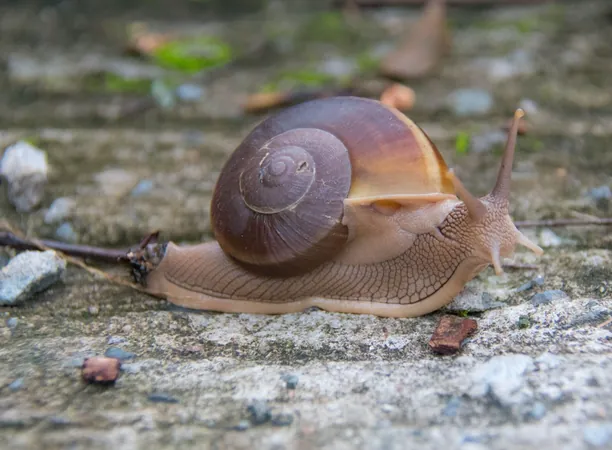
Unlocking the Secrets of Sight: Can Apple Snails Help Us Regenerate Human Eyes?
2025-08-08
Author: Wei Ling
Nature’s Regenerators: The Marvelous Apple Snail
While the human eye is an incredible feat of biological engineering, once damaged, it struggles to heal itself. But revel in the wonders of the golden apple snail—known for its astounding ability to regrow an entire camera-type eye in just a month! This regenerative prowess puts humans to shame.
A Groundbreaking Study Unveiled
In an exciting new study by molecular and cellular biologist Alice Accorsi and her team at the University of California, Davis, researchers discovered fascinating similarities between the anatomy and genetics of apple snail and human eyes.
Leveraging advanced CRISPR-Cas9 genome-editing tools, Accorsi’s team has carved out a valuable system to explore the genetic mechanics of eye regeneration—potentially paving the way for innovative therapies for individuals who have suffered vision loss due to injury or disease.
From Invasive Species to Inspirational Evolved Biology
Pomacea canaliculata, the golden apple snail, hails from South America but has made itself at home as an invasive species across tropical regions. With its rapid breeding cycle and remarkable adaptations, this snail stands out as the perfect specimen for studying regeneration.
"When I first delved into this research, I was surprised no one had used snails to study regeneration before. It turns out we simply hadn’t found the right species—until now!" Accorsi enthused.
Anatomical Twins: How Snail Eyes Reflect Our Own
Unlike simpler creatures, such as planarians or salamanders, which can regenerate only fragments of eyes, the apple snail remarkably rebuilds every feature of its complex eye—complete with a cornea, lens, retina, and optic nerve. Its ocular structure closely mirrors that of vertebrates, allowing for valuable comparisons.
Genetic Blueprint for Regeneration
Combining cutting-edge histology with transcriptome sequencing, the team revealed significant similarities in genes that are essential for eye development in both humans and snails. Key genetic regulators like pax6 and sox2 are present in both species, catalyzing the eye formation process.
Insights into the Regeneration Process
Once the eye stalk is severed, the apple snail springs into action, initiating regeneration within just 24 hours. Cells proliferate and transform into new eye structures, including lens and retinal layers.
Breaking New Grounds with CRISPR
Utilizing CRISPR-Cas9 technology, researchers have begun to manipulate specific genes to further understand their roles in eye development and regrowth. For instance, knocking out the pax6 gene resulted in hatchlings that developed no eyes, confirming its vital role in eye formation.
Exploring the Future of Eye Regeneration for Humans
While humans share these developmental genes, they remain dormant after embryonic development. Discovering how to reactivate these genes could be the key to unlocking self-repair mechanisms in human eye tissues.
From Pests to Pioneers: The Case of the Apple Snail
Accorsi’s work underscores an exciting narrative: sometimes, the answers to complex biomedical questions can be found in the unlikeliest of organisms. With the golden apple snail leading the charge in organ regeneration, it lights the path for future research into not only vision restoration but also broader regenerative medicine.
A Bright Horizon Ahead
With ongoing research, what began as an invader may soon become a revolutionary force in understanding eye regeneration. Stay tuned as Accorsi and her team continue to shed light on future possibilities in restoring human eyesight.



 Brasil (PT)
Brasil (PT)
 Canada (EN)
Canada (EN)
 Chile (ES)
Chile (ES)
 Česko (CS)
Česko (CS)
 대한민국 (KO)
대한민국 (KO)
 España (ES)
España (ES)
 France (FR)
France (FR)
 Hong Kong (EN)
Hong Kong (EN)
 Italia (IT)
Italia (IT)
 日本 (JA)
日本 (JA)
 Magyarország (HU)
Magyarország (HU)
 Norge (NO)
Norge (NO)
 Polska (PL)
Polska (PL)
 Schweiz (DE)
Schweiz (DE)
 Singapore (EN)
Singapore (EN)
 Sverige (SV)
Sverige (SV)
 Suomi (FI)
Suomi (FI)
 Türkiye (TR)
Türkiye (TR)
 الإمارات العربية المتحدة (AR)
الإمارات العربية المتحدة (AR)